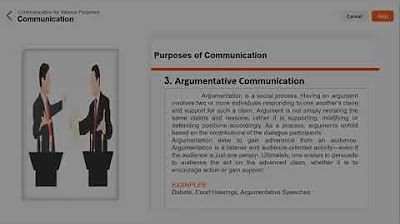Materi Tanggap Wacana
Summary
TLDRThis transcript presents a comprehensive guide to public speaking, focusing on different types of speeches (such as 'tanggap wacono' and 'tanggap wicoro') and their application in educational settings. It outlines the structure of a speech—starting with a greeting, followed by the body, and concluding with a closing statement. Emphasizing the importance of preparation and practice, the script offers practical advice for students to improve their speech delivery, both in planned and impromptu scenarios. The content concludes with motivating words to encourage students in their learning journey, while highlighting cultural aspects of Javanese public speaking.
Takeaways
- 😀 Public speaking, or 'pidato,' is a common activity aimed at delivering a message to an audience for a specific purpose, such as providing information, offering comfort, or persuading others.
- 😀 A speech, in Javanese culture, is categorized into several types, including formal and informal speeches, with varying levels of preparedness, such as spontaneous and structured speeches.
- 😀 The goal of a speech can vary, such as giving information, providing entertainment, or offering emotional support, depending on the context and the speaker's intention.
- 😀 The structure of a speech generally includes an introduction, body, and conclusion. Each section serves a specific purpose in delivering the message effectively.
- 😀 An effective speech should align with the theme and objective of the event, making the content relevant and engaging to the audience.
- 😀 The speech should maintain a clear and strong voice (suara), ensuring that the speaker's tone and delivery are appropriate for the context.
- 😀 Proper organization and coherence are essential when delivering a speech, as it helps the audience follow along and retain the information being shared.
- 😀 The introduction (pambuko) is crucial for setting the tone, including greetings, respect, and gratitude towards the audience and organizers.
- 😀 The main body of the speech (Suroso) contains the core message, which should be well-organized, clear, and related to the speech's purpose.
- 😀 A good conclusion should summarize the main points and provide an appeal or call to action, ensuring the audience leaves with a lasting impression.
Q & A
What is the primary topic of the speech presented in the transcript?
-The primary topic of the speech is about the importance and practice of giving speeches (pidato) in Javanese, including its forms, purposes, and structure, particularly focusing on a practice test for students.
What are the different types of speeches mentioned in the script?
-The script mentions two types of speeches: 'tanggap wacono' (response to a speech) and 'tanggap wicoro' (response to a presentation). These are further divided into 'kondisi ok' (structured, planned) and 'kondisi dadakan' (spontaneous).
What is the significance of 'tanggap wacono' and how is it categorized?
-'Tanggap wacono' refers to a response given after a speech or presentation. It is categorized into 'kondisi ok' (planned response) and 'kondisi dadakan' (spontaneous response), where the planned response is more structured and the spontaneous one is given without prior preparation.
What role does 'tanggap wicoro' play in the context of the speech?
-'Tanggap wicoro' refers to an individual's response during or after a speech, which can either provide information, offer an opinion, or give comfort. It helps engage the audience and offers clarity on the discussed topic.
What are the three main purposes of giving a speech as outlined in the transcript?
-The three main purposes of giving a speech mentioned are to provide information, to share an opinion, and to offer comfort or entertainment.
How is the structure of a speech explained in the transcript?
-The structure of a speech in the transcript is divided into three main parts: the introduction (pembukaan), the main body (suroso), and the conclusion (penutupan). Each section serves a specific function in organizing and delivering the speech effectively.
What are some of the common mistakes or issues that could arise during a speech according to the transcript?
-Common issues include unclear pronunciation, improper tone, and lack of alignment with the audience's expectations. These can detract from the clarity and impact of the message being delivered.
What does 'tanggap wacono' represent in terms of interaction with the audience?
-'Tanggap wacono' represents the audience's response to a speech or presentation. It can be in the form of feedback, questions, or comments that either engage the speaker or provide a reaction to the content being shared.
What is the role of 'tutup' or closing in a speech?
-The closing section of a speech ('tutup') is where the speaker summarizes the key points, expresses hopes or expectations for the future, and formally ends the speech, often with a farewell or an apology if necessary.
How does the script emphasize the importance of preparation in giving a speech?
-The script stresses that preparation is key for a well-structured speech, with an emphasis on knowing the content and having a clear, confident delivery. The contrast between planned and spontaneous speeches highlights how preparation can influence the effectiveness of the presentation.
Outlines

此内容仅限付费用户访问。 请升级后访问。
立即升级Mindmap

此内容仅限付费用户访问。 请升级后访问。
立即升级Keywords

此内容仅限付费用户访问。 请升级后访问。
立即升级Highlights

此内容仅限付费用户访问。 请升级后访问。
立即升级Transcripts

此内容仅限付费用户访问。 请升级后访问。
立即升级浏览更多相关视频

materi ceramah kelas XI sma bahasa indonesia

PAMERAN - MATERI SENI BUDAYA KELAS 9 BAB X SMP/MTS SEMESTER 2

DELIVERY FOR DIFFERENT SPEECH SITUATIONS|WEEK 10 MODULE|ORAL COMMUNICATION IN CONTEXT

Workshop Public Speaking (Sesi 2 Manajemen Public Speaking) | SP2KM

Materi Biantara Basa Sunda Kelas X SMA, MA Semester Ganjil

PURPOSIVE COMMUNICATION CHAPTER 6: COMMUNICATION FOR VARIOUS PURPOSES
5.0 / 5 (0 votes)
